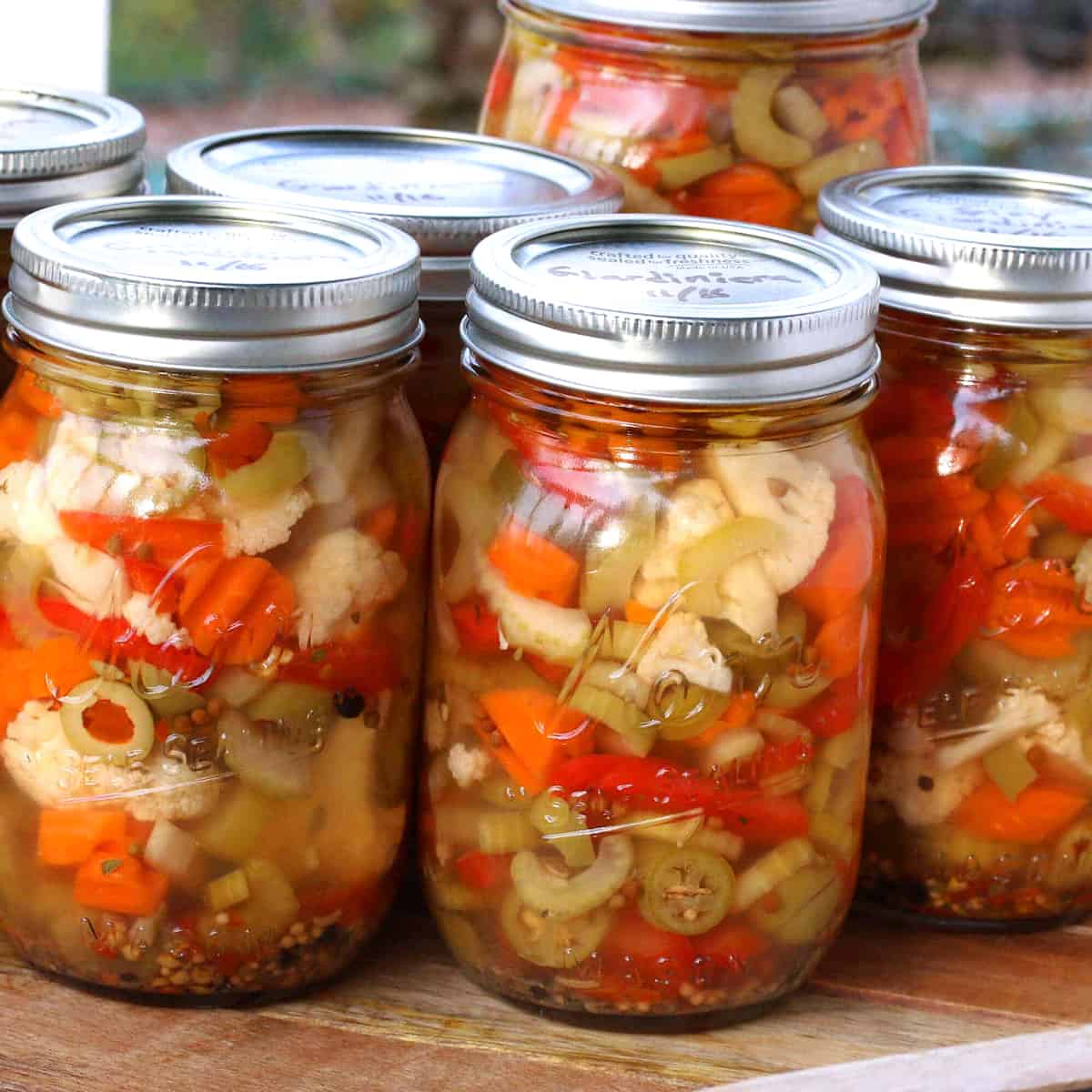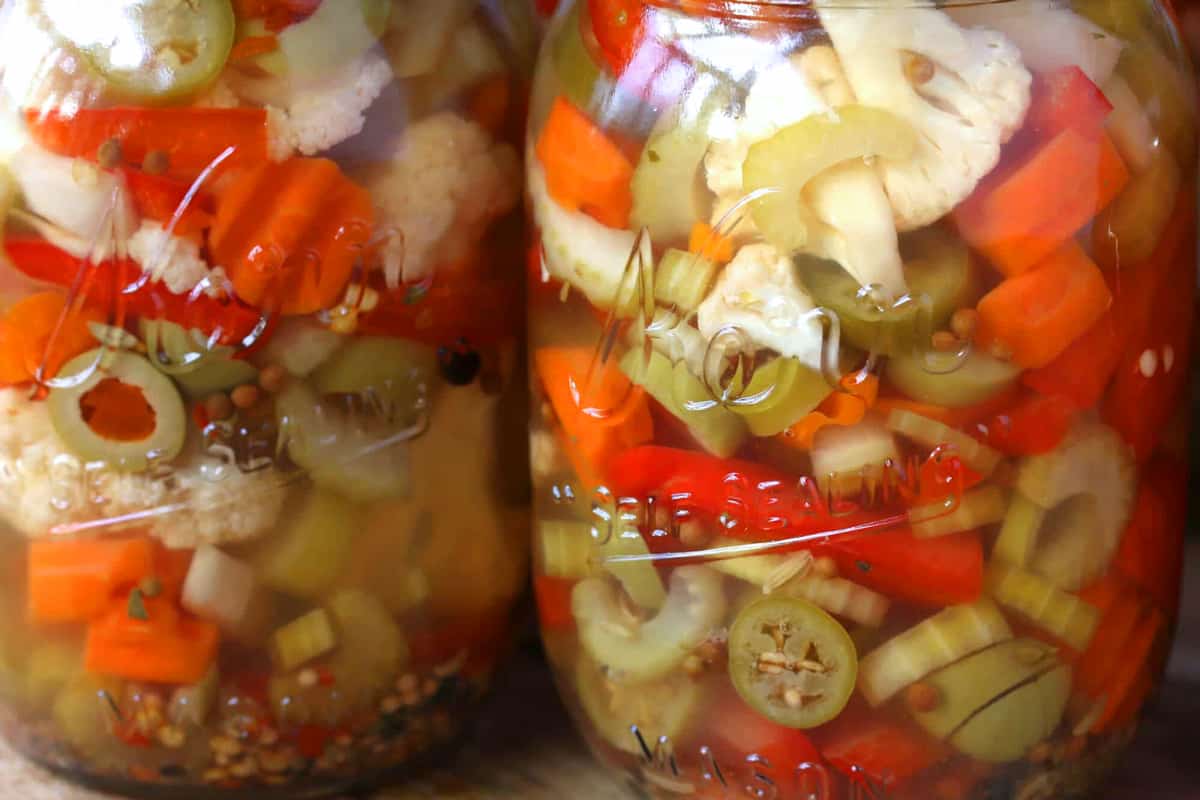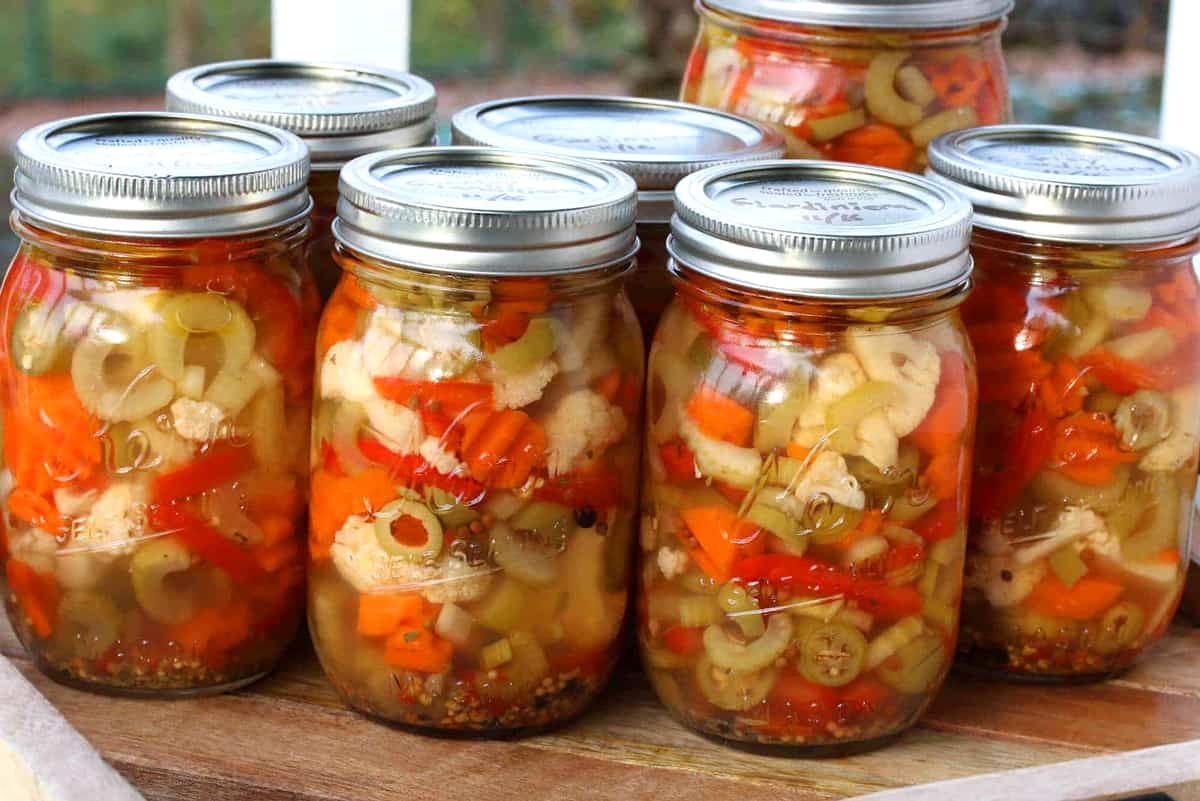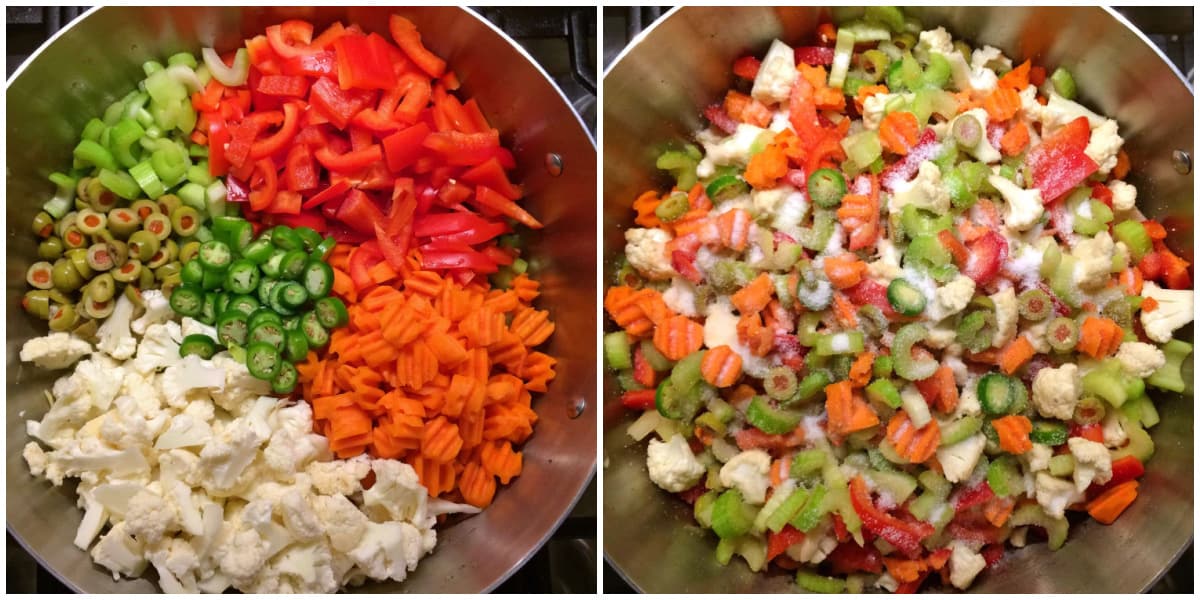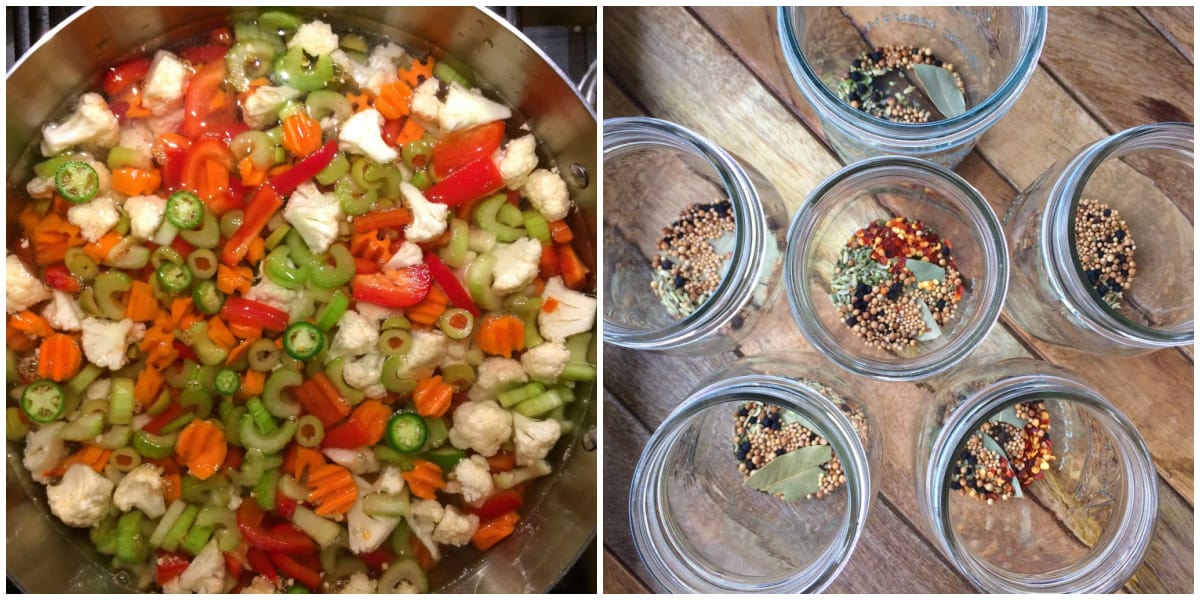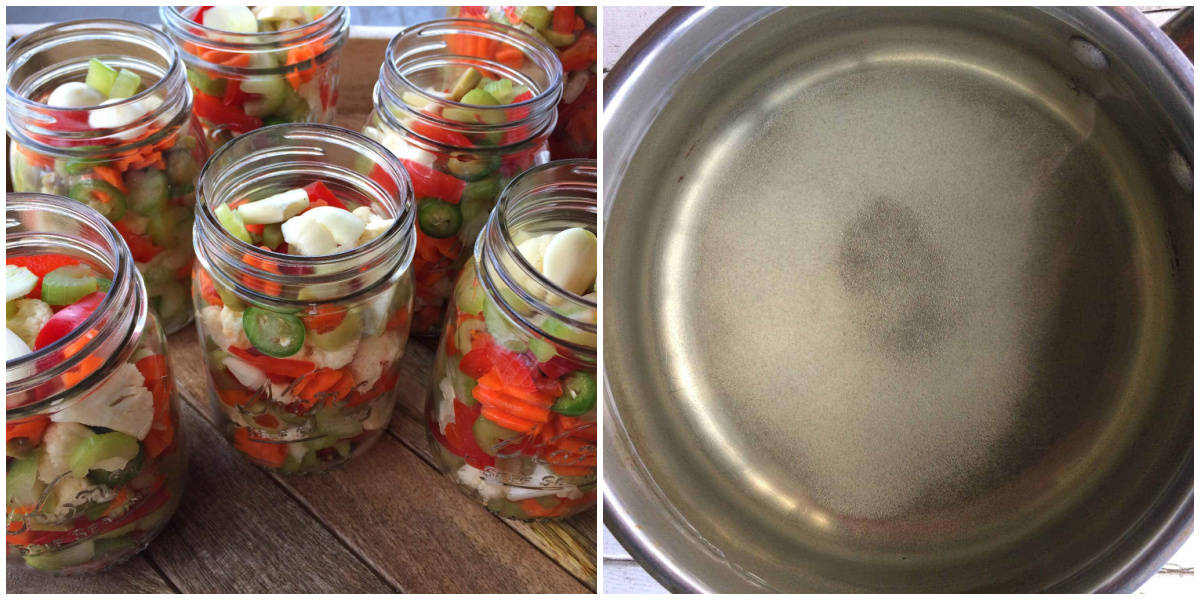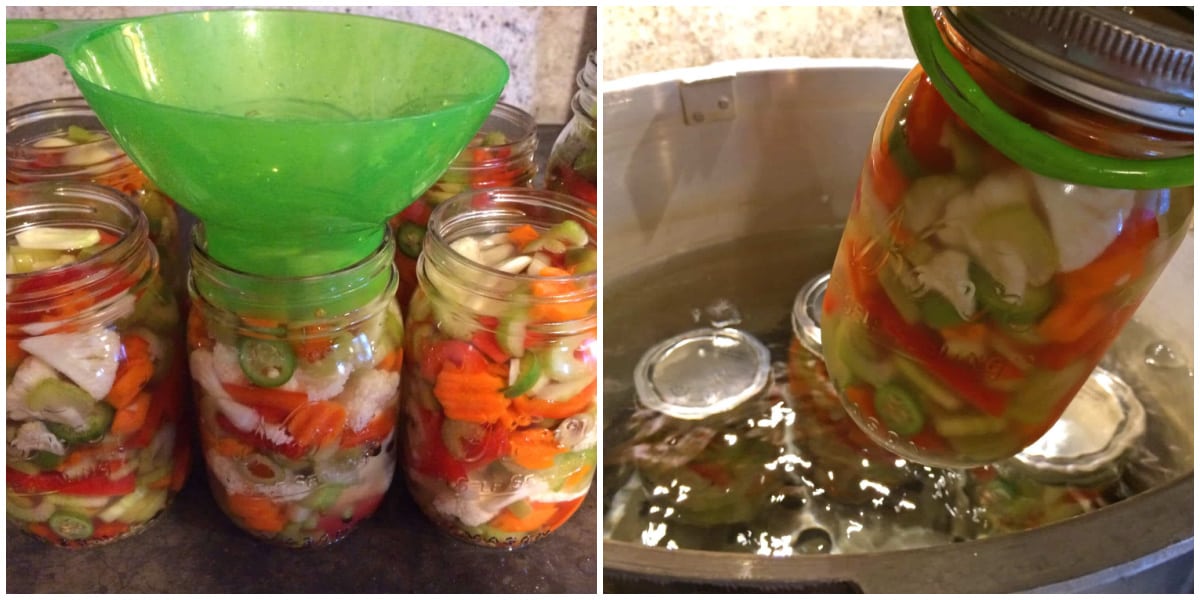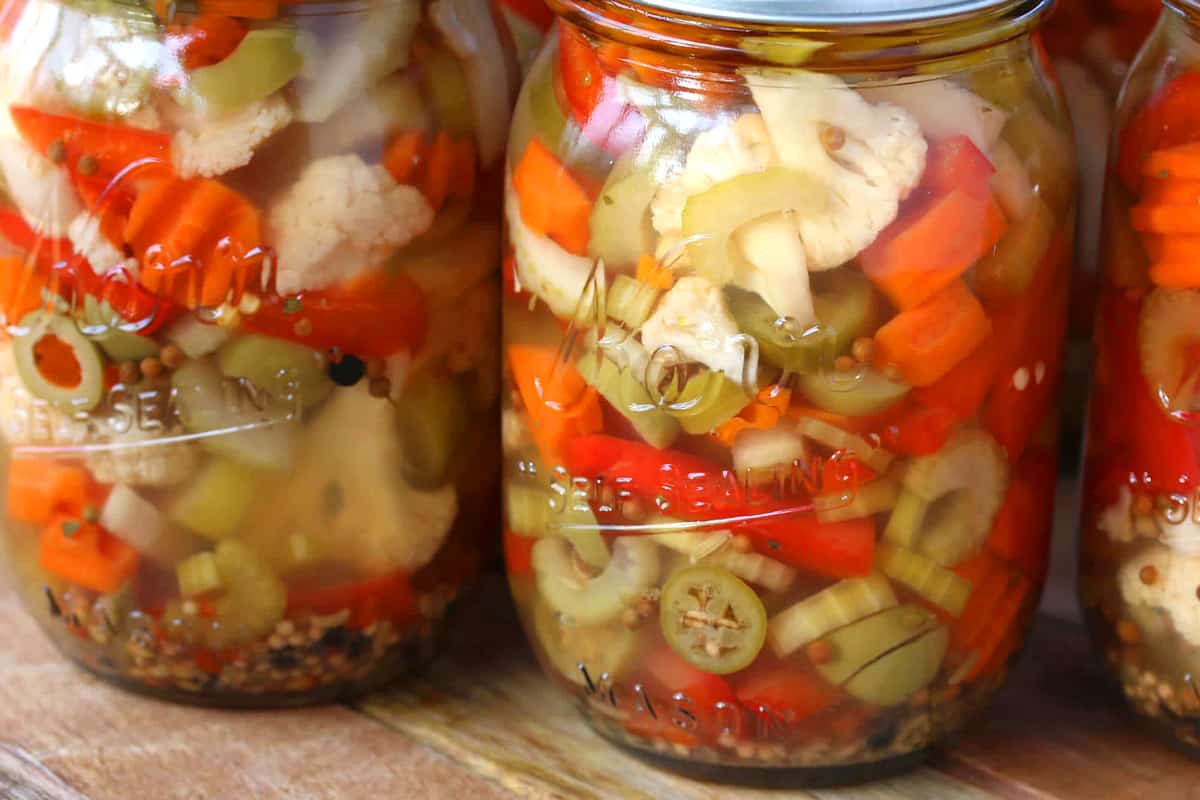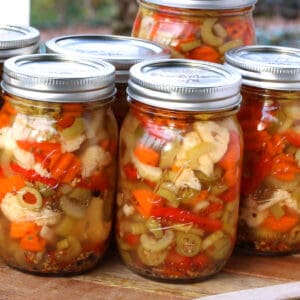Not just for hot dogs and muffuletta sandwiches, add this homemade giardiniera to your burgers, nachos, pizzas, pasta salads and anything else your heart desires! This Italian giardiniera recipe is simply the BEST (just check out the rave reviews below). I promise, once you’ve tried this you’ll be hooked for life!
What is Giardiniera?
Giardiniera, pronounced “jar-din-air-ah”, is one condiment you don’t want to be without. And once you’ve tried it you’ll understand why. Originating in Italy, these pickled vegetables were introduced to Chicago in the late 19th century by Italian immigrants and took their place as arguably the city’s most popular condiment. It’s used on practically everything! You name it, giardiniera is just what you need to bring your hot dogs, burgers, sandwiches, nachos, antipasto platters and pasta salads to life. In Chicago you’ll even commonly find it served on pizzas and, of course, no Italian beef sandwich is complete without it. Have you been to New Orleans? Giardiniera is the magical ingredient in those mouthwatering muffuletta sandwiches. In short, giardiniera is the ultimate pickled vegetable relish!
Giardiniera Ingredients & Variations
Vegetables: I’m using serrano peppers in this but you can also use jalapenos. You can customize the heat level by adding more or less. We’re also adding a couple of red bell peppers to mix for sweetness and a pop of color. Other vegetables in classic giardiniera are cauliflower, carrots, celery, and some pitted green olives (I love the brininess they contribute). Feel free to add other vegetables if you like, for example pearl onions and green beans. Vinegar and Oil: We’re using an equal amount of white wine vinegar and water, which is the right ratio for making this giardiniera recipe safe for canning if you so choose. The white wine vinegar contributes a great flavor and isn’t as harsh as white vinegar. In addition we’re topping off the jars with a little olive oil. If you’re not canning the giardiniera you can add more. Seasonings: Garlic is a must. For the spices I really love the combination of oregano, coriander seeds, yellow mustards, fennel seeds, black peppercorns, red pepper flakes, celery seeds and bay leaf. Feel free to change up the ratios or experiment with other spices and herbs like cloves, allspice berries or juniper berries.
The popularity of giardiniera has continued to explode in Chicago with more than a million pounds of it being sold annually. Still it remains relatively unknown outside of the Windy City except among those with strong Italian roots. So if you’ve never heard of or tried it before, now is your chance to make some absolutely delectable homemade giardiniera that will bring new life and flavor to your favorite foods!
You can chop the veggies however large or small you prefer. In Italy the vegetables are usually left in fairly large pieces and that way it’s also more versatile. Left in larger pieces you have the flexibility of serving the giardiniera with your charctuerie/antipasto platters and when you want to use it for sandwiches, hot dogs, pasta salads, etc, you can simply diced up the finished giardiniera into smaller chunks. But left large or diced small, you are simply going to LOVE this giardiniera!
How to Can Giardiniera
As with other pickled vegetables, giardiniera can be canned using the water bath canning method. No need to pull out the pressure canner. In the step-by-step pictured instructions below I’m including all the information you need on how to can giardiniera so that you can store it long-term to enjoy all year round.
Ways to Enjoy It
Giardiniera can be used in various ways to add a zesty and crunchy element to your dishes. Here are a few ideas:
Sandwiches and Wraps: It adds a nice crunchy texture and a burst of flavor to the mix. And of course it’s a MUST in your muffuletta sandwich! Salads: Toss giardiniera into salads to provide an extra flavor and crunch. Add some to your Macaroni Salad, Potato Salad, and leafy green salads. Pizza and Flatbreads: Sprinkle some over your pizza or flatbread before or after baking. It adds a nice bit of tang, richness, and texture. Antipasto Platter: Giardiniera is a classic component of antipasto platters. Arrange it alongside cured meats, cheeses, olives, and other pickled items as part of your cheese and charcuterie board. Hot Dogs and Sausages: Use it as a topping for hot dogs, brats and sausages. It’s a fun and tasty alternative to the more traditional toppings. Tuna or Chicken Salad: Mix it into tuna or Chicken Salad to give it a zesty kick of flavor and some contrasting texture. Omelets and Scrambled Eggs: Fold some into your omelet or scrambled eggs for flavor and crunch. Grains, Grain Bowls and Rice Dishes: Incorporate it into your grains, grain salads (like my Greek Wheat Berry Salad), grain bowls, and rice dishes for flavor, color and texture. Burgers: Top your burgers with it for a fun and tasty flavor twist.
Giardiniera Recipe
Let’s get started! Chop up the veggies and place them in a large non-reactive pot or bowl. If you’re wondering how to get the crinkle-cut carrots, use a mandolin slicer that has that ability. Pour 1/4 cup kosher salt over the vegetables. Pour enough water over the vegetables to cover them. Let them soak in the salt water for at least 6 hours or overnight. This step is critical for drawing out excess water from the vegetables which would otherwise dilute the vinegar brine and lead to spoilage. To prepare the jars, place the spices into each of the jars. I like to make some batches hot and some mild. Do that by using or omitting red chili flakes. For a true Chicago-style giardiniera you’ll want to make it hot! Thoroughly rinse and drain the vegetables before dividing them up between the jars. Pack the vegetables in as tightly as you can. Place the garlic each jar. Now we’re making a vinegar solution to pickle the vegetables. To play it safe Cooperative Extension Service sources recommend a 1:1 ratio of vinegar to water. Some other recipes may have a lighter vinegar brine but if you’re planning on storing your giardiniera for more than 2 weeks, we recommend this ratio to create enough acidity to prevent the risk of unwanted bacteria. Bring the water, vinegar and salt to a boil. Pour the boiling brine over the vegetables leaving a little more than 1/2 inch headspace from the top. Pour the olive oil over the top. **Omit the oil if you are proceeding with water bath canning the jars. Wipe the rims with a wet paper towel and seal the jars. If you plan on using the giardiniera within two weeks let the jars sit at room temperature for a day or two and then transfer them to the fridge. If you’re canning the giardiniera for long-term storage, seal the jars with the lids and rims and prepare a boiling water bath. Boil the jars for 10 minutes. Carefully remove the jars and let them sit undisturbed for 24 hours before moving them. Adjustments for high altitudes:
At 1,001 to 6,000 feet (305 to 1,829 meters) above sea level: increase processing time by 5 minutes. Above 6,000 feet (1,829 meters) above sea level: increase processing time by 10 minutes.
If processed in the water bath, the giardiniera is best consumed within 6 months but will keep for up to a year. Enjoy!
For more great pickled veggie and relish recipes be sure to try our:
Dill Pickle Relish Sweet Pickle Relish Sweet Corn Relish Sweet Pepper & Onion Relish Pickled Onions Pickled Banana Peppers Pickled Pepperoncini Peppers Pickled Carrots Pickled Jalapenos Pickled Beets
Originally published on The Daring Gourmet August 21, 2017 Read more about me…
